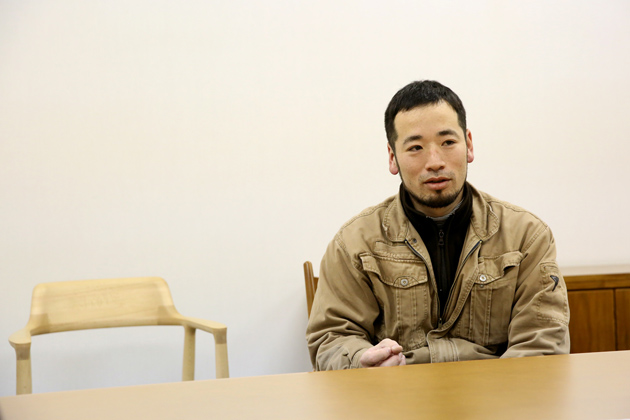
Interview: Maruni Craftsman Taketsugu
JAPANTWO(JP2):I heard that you became in charge of the final polishing stage for the HIROSHIMA chair at a young age. What brought you into that position?
Craftsman Taketsugu(Mr. Taketsugu):The person working the position suddenly left, so I ended up taking over his job. I became in charge of that position quicker than I had expected.
JP2:How did you feel when you first started in that position?
Mr. Taketsugu:It was really difficult. I had to polish many pieces in a day, and I wasn't really accustomed to that particular work. I spent some time wrestling through the work. I focused on maintaining the quality while I polished it. As a result, I improved quickly in short time.
JP2:What's the most difficult part of the final stage of making HIROSHIMA ?
Mr. Taketsugu:Concerning the design of the HIROSHIMA, Naoto Fukasawa gave us detailed instructions for the majority of the parts. However, there were some uncertain parts. The shape varied depending on the person in charge, so it was quite difficult to keep them uniform. Fukasawa is a very detail-oriented person, so we showed the final product, and he and the people from R&D got together and requested various changes. Little by little, we were able to improve and meet their standards.
If we shaped the HIROSHIMA with only a machine, it would give them a "cold" feel, so we tried polishing one at a time by hand to give them a sense of warmth feel.
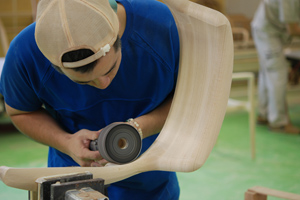
JP2:How did you feel when you got the requests from Fukasawa?
Mr. Taketsugu:At first, I was like, "Really? Again?" However, I wanted to meet his expectations, and so I adjusted it little by little. I tried to imagine how Fukasawa had constructed it in his head.
JP2:Is it enjoyable experience even with the challenges?
Mr. Taketsugu:Of course it’s fun. The machining process leaves little bumps on the wood surface which gives the product a slightly "cold" feel. I try to even out the curves, making it a little more round and give them "warm" touch.
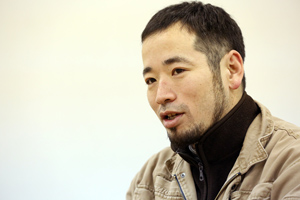
JP2:HIROSHIMA is the trademark product of Maruni. As the person responsible for the final stage of its manufacturing process, is there anything that you always keep in mind?
Mr. Taketsugu:As you can see, the HIROSHIMA does not contain any hidden parts. Almost all of the parts can be seen, so I always try to give it a fine finish and put in my best effort while I work on each chair.
JP2:Do you think about the customers who will be using the furniture when you are working on it?
Mr. Taketsugu:Definitely. Even if it's one out of the hundreds we make, for the customers that chair will be one of four or even the one of the chair, so we make them carefully. That's just about it.
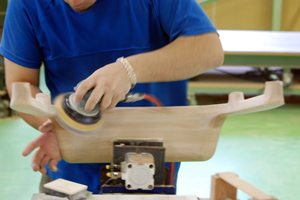
JP2:What is the key to quality polishing?
Mr. Taketsugu:Touching. You touch it and you polish the unevenness until it feels even. We also put it under a light and check if there is any unevenness on the surface, but we need to keep on touching it. We repeat this process until we are satisfied with it.
JP2:Does it feel different depending on the chair?
Mr. Taketsugu:Yes, it does because each wood has different character. I try to make them as uniform as possible even though they feel different. The difference may result from the different people polishing the wood, so at the end, I try to make them look as if they are the same product.
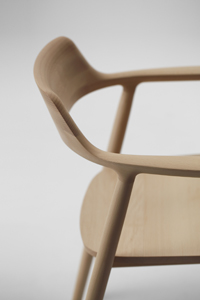
JP2:Which part of HIROSHIMA would you like to highlight to those who are not familiar with the chair?
Mr. Taketsugu:Just touch a HIROSHIMA chair, and you can immediately understand what’s so great about it without any explanation. Touch the chair, and take a seat, and feel the chair. Honestly, HIROSHIMA is something that I want to have myself. Although I'm the one who works on the products, I don't have many opportunities to sit on them. However, there was a time when they returned a chair back to the factory because the wood grains weren't good, so I took the chair to the staff room and sat on it. Then, I remember that it felt quite good and was really surprised by it. I thought, "I never imagined that it was a chair like this" From that moment onwards, I felt that it is necessary to sit on the chair that I work on.
JP2:Why do you think Maruni's products are recognized globally?
Mr. Taketsugu:I believe it's the result of the detailed work done at each stage in the process. For example, a simple hole is measured exactly before being drilled. A basic task with precision creates the fine product. We don't compromise with sloppy work, and we stick with the piece until it is done right. Repeating these basic and precise steps is what makes the furniture of Maruni, and it is the reason why we are recognized by many people.
JP2:Did HIROSHIMA become the turning point for Maruni?
Mr. Taketsugu:I think so. I think the timing was right. The HIROSHIMA was the chair that had never existed before. Initially, I wondered who would actually buy a chair like this. When I started off, it took 1 hour just to finish up the polishing a single chair. Even if I worked hard for 8 hours, I could only finish 8 chairs in a day. Now, I’ve got a little more accustomed to this process, and I divide the task up so I can finish about 20 to 30 chairs in a day. The quality of my work has definitely gotten better since the time it took me an hour per chair, so looking back, I guess I have improved a lot.
JP2:How did you feel when you saw HIROSHIMA outside of the factory?
Mr. Taketsugu:My heart races.
Recently, there have been a lot of factory tours, and it's really interesting to see the people’ reaction up front when they take a look and touch the HIROSHIMA. I am pleased to seeing the customers who enjoy watching the process of making chair. It was the moment I realized how important to see people’s reactions to the chair and made me think that I need to continue to give it my very best.
Maruni Wood Industry
Websitehttp://www.maruni.com/en/
